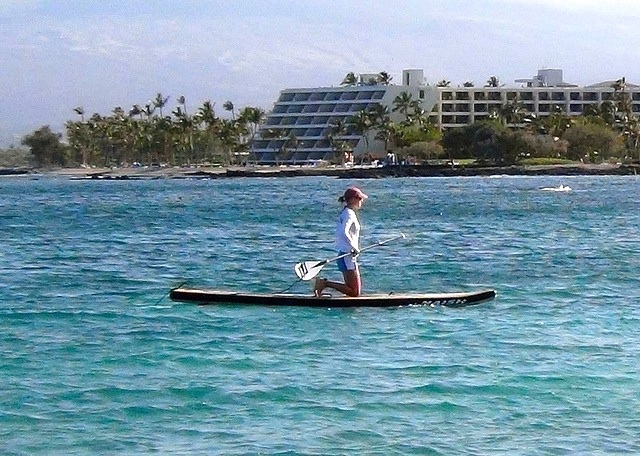
Stand up paddling is one of the fastest growing water sports in the World. That’s impressive and if you haven’t jumped on the bandwagon yet then there is no time like the present.
I started stand up paddling a few years ago and quickly became completely and totally addicted. It tends to have that affect on people.
The Basics
Stand up paddleboards also known in abbreviated form as SUP’s come in many different shapes and sizes. They can be used for cruising lakes, touring ocean bays, fishing, surfing, river running, or just plain goofing around having fun.
Paddling an SUP targets your core muscles the most but also provides an awesome full body workout. You may find even your toe muscles building strength.
It can be intimidating when first starting out and you may have the idea in your head that you will end up in the water more than you will be on your board.
Below are some very common beginner questions. Hopefully the answers to these questions will help you to feel more confident to give this awesome sport a try.
Beginner Questions & Answers
1. How hard is it to stay up on those things?
This is the number one question I get from people who have never tried stand-up paddling. I have had people stop me at the beach to ask this question and I have even had swimmers and snorkelers come up to me in the water and ask.
The truth is that it only takes a very short adjustment period before you are looking like one of the pros, at least when on flat water.
If you follow a few basic steps your first time or two out, you may never even fall in. However I almost think it is better if you do as then you can get rid of the fear of falling.
So what are the basic steps to follow? See the next question…
2. What is the easiest way to get comfortable on an SUP?
Ok, here are the steps to take that I learned my first time out.
- First start it in flat calm water. That means go on a day when there is very little wind and the water is as calm as possible.
- Use a beginner board – a board that is wide and thick. Or use a board that is best suited for your weight (see answer to question 3 for more details on this).
- Place your board in the water and climb onto it on your hands and knees. Then sit back on your knees.
- Start off by paddling while sitting on your knees.
- When you are feeling comfortable slowly stand up one foot at a time keeping your feet shoulder width apart.
- Practice paddling while standing. If you begin to feel uncomfortable at any time go back down on your knees as this is a very stable position.
You can also try paddling your board by sitting on your bum. However it is worth noting that it is much harder to stand up from this position than it is from your knees.
If you fall in, don’t worry about it. Just climb back on your board and try again. It’s really a lot of fun.

3. What size board should I use?
When you get to an intermediate level, you will want to be a little pickier with your board size. However for beginner to novice paddlers the rough guide below will suffice.
The right size board for you will depend on three factors:
- Water Conditions – Longer and slimmer boards are great for flat water because they glide nicely and can reach good speeds. However they will not be as maneuverable in rough water or surf. Smaller boards are often favored for surfing. Wider boards are known to be more stable.
- Your weight – If you are very lightweight meaning less than 120 lbs. you can do well on a 10’ board or smaller. Over 120 lbs. and you can use a longer board such as 11 feet. If you are over 170 lbs., you should definitely stick to a board that is 11 feet or longer. A 4” thick board is great for people less than 160 pounds. If you are over 160 lbs., a thicker board will support you better.
- Convenience – meaning what you can easily carry and transport – It’s one thing to get a big board that is super stable but if you are unable to carry it or transport it with your vehicle then it’s useless. An inflatable SUP is a little easier as it can be deflated and transported anywhere.
4. What equipment do I need?
It is important to make sure you have the proper equipment. There are 4 main things you will need:
Stand Up Paddle Board – Obviously you will need a board. There are many to choose from and a wide price range so you should be able to find one to suit your needs.
SUP Paddle – SUP paddles have a handle at one end and a blade at the other. They are constructed with a variety of different materials such as plastic, aluminum, carbon fiber and even wood. The weight of the paddle will vary depending on the material that it is made with.
As far as the length of your paddle goes, it should be between 6 – 10 inches longer than you are. If you will be paddling mostly in flat water then choose a longer paddle. If you will be paddling mostly in surf, then choose a paddle on the shorter side.
Board Leash – The leash is very important as it will keep your board attached to you if you fall in the water. Always remember to use it!
It will attach to one end of your board and the other end will wrap around either your ankle or calf with Velcro.
I have always preferred an ankle leash and surprisingly they are quite comfortable. They come in a variety of sizes. As a general rule, you want a leash that is roughly about the same length as your board.
PFD – I see a lot of people who do not wear lifejackets while stand-up paddling. I can understand why they do not want to but if you are paddling in deep water that is beyond the surfing and swimming limits, you are required to wear one by the US Coast Guard.
I often paddle very close to shore or within surfing limits and therefore will not use a PFD. With my leash attached and the fact that I can swim well, I feel confident that I can make it back to my board if I fall.
However when ocean paddling out of swimming or surfing limits or anywhere that I feel slightly uncomfortable, I do use a PFD. I found this great lifejacket that works really well for stand up paddling. Basically it’s a waist pack with a deflated life vest inside and a CO2 cartridge.
If you fall, you simply pull the little tab and your life jacket inflates. It’s fantastic for stand up paddle boarding as it does not restrict your paddling motion or get uncomfortable or hot.
Bottom line is… if you have to wear one, there are options so that you stay comfortable and safe.
5. How Do I Transport My SUP?
If you have a hard-shell board then you either have to transport it in the back of a truck or on top of a roof rack.
One of the reason’s I love inflatable SUP’s so much is that they are super convenient for transporting to and from the water as well as for travel. Just deflate it, roll it into its carry bag and throw it in the trunk of your car or check it on an airplane… seriously convenient.
As far as carrying your board to and from the water, they all have carry handles at the center of the board and most are easily carried with one arm.
6. How Do I Use My Paddle?
This is an excellent question that many beginners get wrong. The paddle should be held with one hand at the top and the other one on the shaft. Make sure you do not paddle with both hands on the shaft.
Your grip on the paddle should be roughly shoulder width apart as this will allow you to get the most power.
When you take a stroke, dip the blade of the paddle fully in the water. If you are having trouble completely dunking the blade in the water then your paddle is too short for you.
Tighten your core for support and take a long stroke in the water. See the second video below for a demonstration on how to use your paddle properly.
7. What Are The Basic Strokes?
You should have a general idea of the fundamental strokes before you begin. I could explain the strokes here in writing but if you are anything like me, you will need to see them in order to fully grasp them.
The guys over at Werner Paddles Blog have set up these 5 great instructional videos that are totally worth watching. They are very well done.
This first video is an introduction and covers some basics and stretching.
This second video covers how to hold your paddle properly for the most power and comfort and the basic stroke.
This third video continues on with the forward stroke and talks about using your hips and timing.
The fourth video gets a little more technical in order to achieve a more efficient stroke.
The fifth video features skills to make turning easier.
Hope these questions and answers help. If you are still feeling nervous the best thing to do is just get out there and try it. SUP rental companies are popping up all over the place so it is easy to try it out before you purchase a board. You will probably surprise yourself and be thrilled at how easy it really is.
Looking for the right board? Click Here To See Our Top 5 Inflatable SUP’s.
 Types of Stand-Up Paddling
Types of Stand-Up Paddling 3 Factors In The Rise Of Stand-Up Paddling
3 Factors In The Rise Of Stand-Up Paddling SUP Fitness Tips
SUP Fitness Tips The Growing Sport of Stand Up Paddling
The Growing Sport of Stand Up Paddling




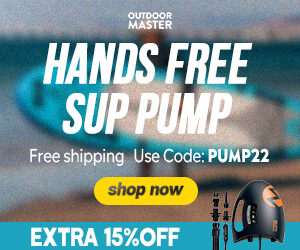
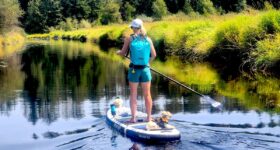


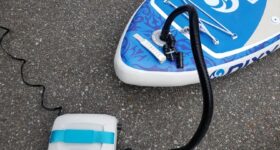
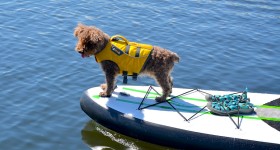

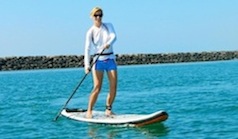
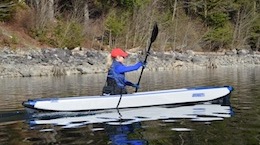
Fantastic beginner’s guide! thank you. I recently fell in love with the said sport. Exploring what our nature has to offer and getting to do our outdoor exercises are always good. I find it both mentally and physically addictive! Really happy to its increasing popularity these days and here are the reasons why :
https://3dfins.com.au/blogs/media-spotlight/the-rising-popularity-of-stand-up-paddleboardingBlog